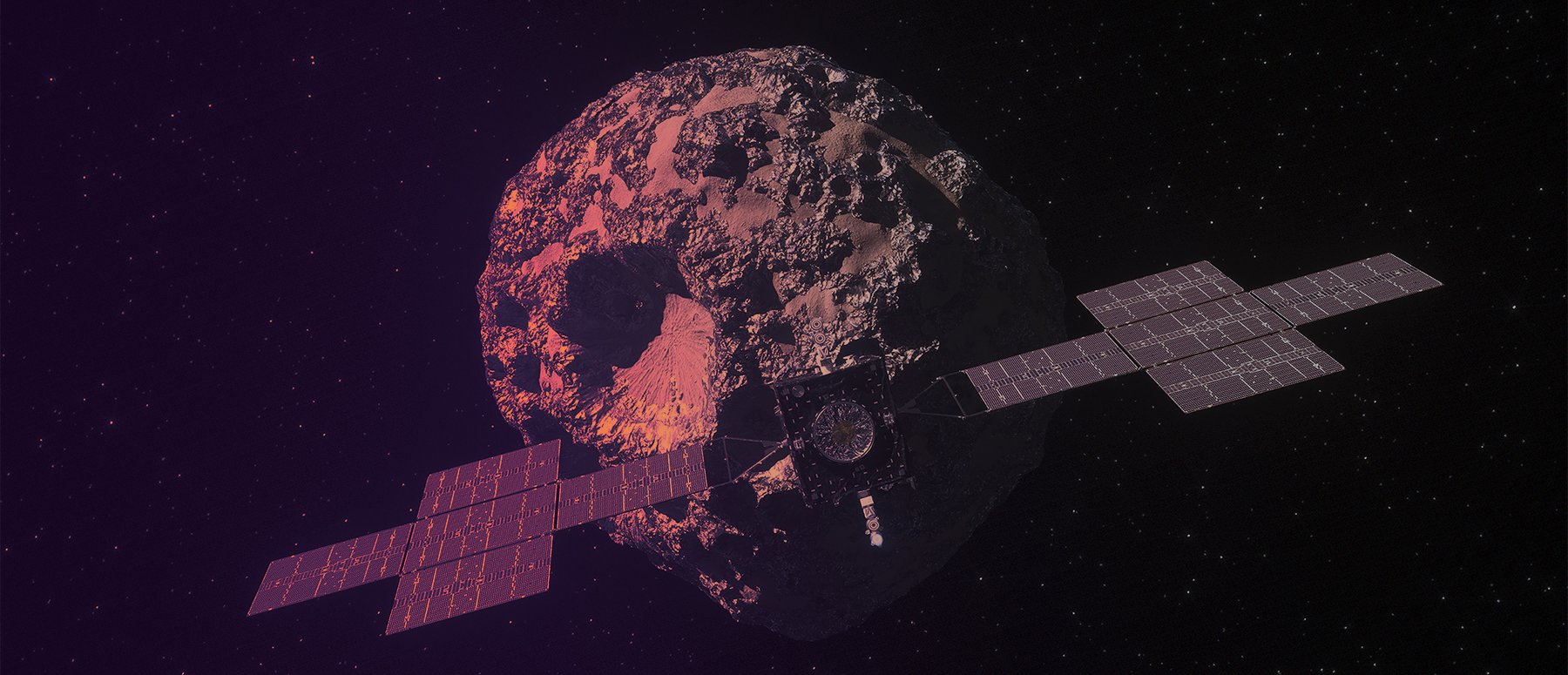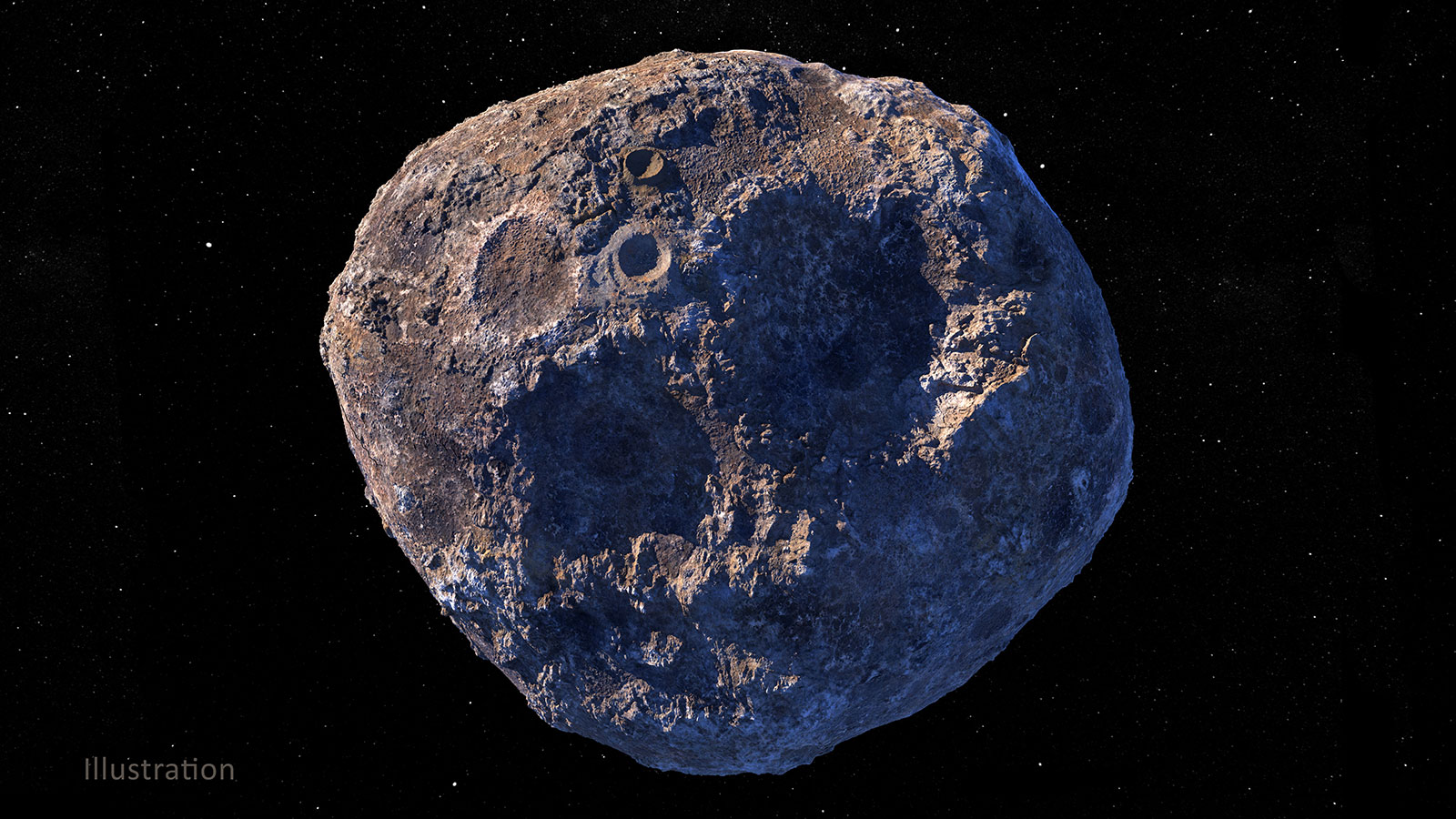On October 13th, at 10:19 AM Eastern (07:19 AM Pacific), NASA’s Psyche mission successfully launched atop a SpaceX Falcon Heavy rocket from Launch Pad 39A at NASA’s Kennedy Space Center in Florida. This spacecraft is now on its way to rendezvous with the M-type asteroid of the same name, an object in the Main Asteroid Belt almost entirely composed of metal. This metallic asteroid is thought to be the remnant of a planetoid that lost its outer layers, leaving behind a core of iron-nickel and precious metals. By studying this object, scientists hope to learn more about the formation of rocky planets.
Continue reading “NASA's Psyche Mission is off to Asteroid Psyche”Psyche Mission Passes Independent Review Board with Flying Colors

An independently appointed review board recently announced that NASA, their Jet Propulsion Laboratory (JPL), and the California Institute of Technology (Caltech) have exceeded expectations in taking steps to ensure the successful launch of the metal-rich-asteroid-hunting Psyche mission this October. This comes after Psyche’s initial launch date was delayed from August 2022 due to late delivery of the spacecraft’s flight software and testing equipment, which prevented engineers from performing the necessary checkouts prior to launch.
Continue reading “Psyche Mission Passes Independent Review Board with Flying Colors”NASA’s Psyche Mission is Back on. It’ll Launch Towards its Metal Asteroid Target Later This Year
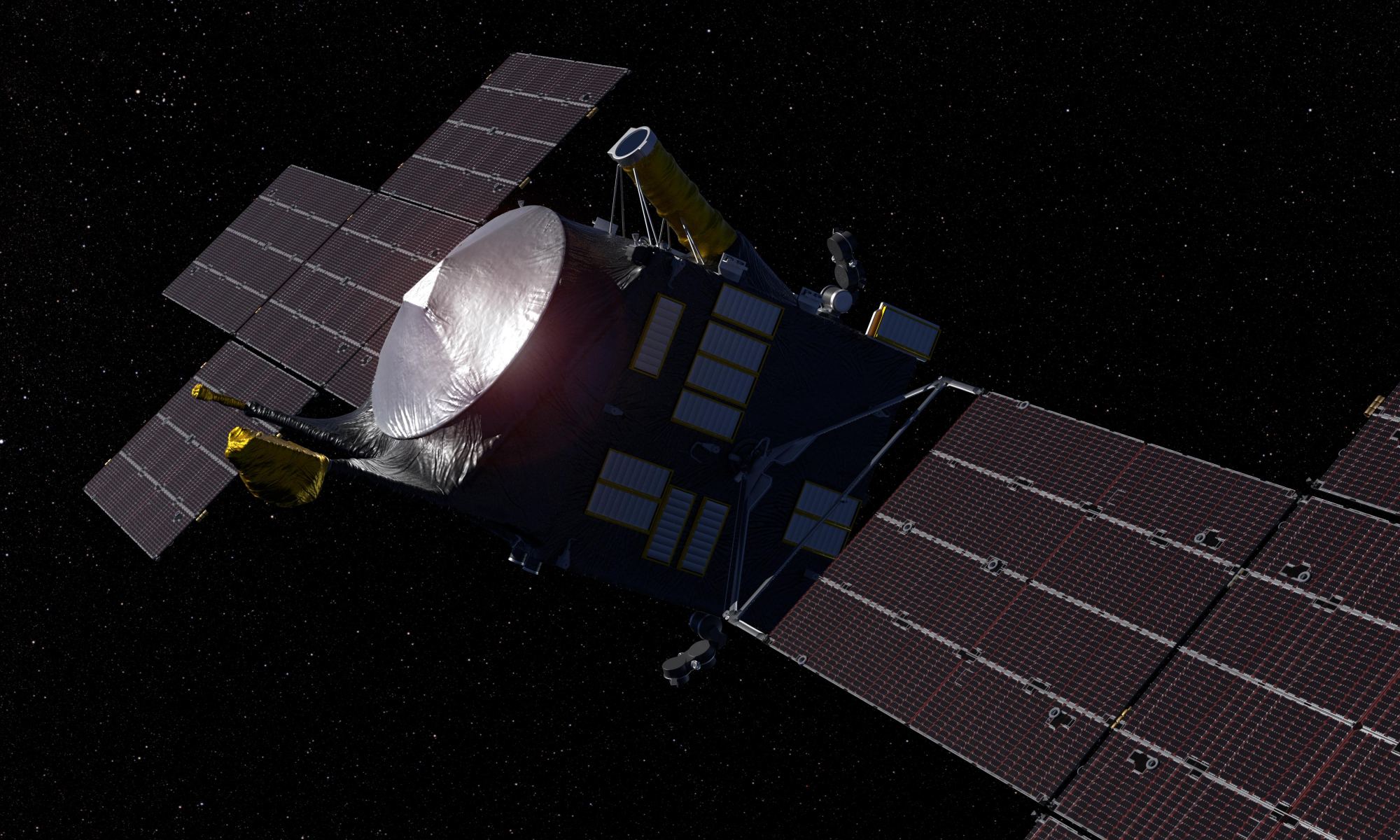
NASA’s Psyche mission is back on track for launch and is now scheduled for a potential October 2023 launch date, according to an October 2022 statement from NASA. This comes after missing its originally planned launch date between August and October of 2022, and becoming subject to an independent review board, whose results were announced in November 2022.
Continue reading “NASA’s Psyche Mission is Back on. It’ll Launch Towards its Metal Asteroid Target Later This Year”Uh Oh, NASA is Reviewing Psyche and May Terminate the Mission

NASA is reviewing its mission to visit the asteroid 16 Psyche. The Administration has convened a 15-member review board to examine the mission and its failure to meet the scheduled 2022 launch. The review began on July 19, and the board will present their findings to NASA and JPL in late September.
Continue reading “Uh Oh, NASA is Reviewing Psyche and May Terminate the Mission”This is What the Metal Asteroid Psyche Might Look Like

If you wanted to do a forensic study of the Solar System, you might head for the main asteroid belt between Mars and Jupiter. That’s where you can find ancient rocks from the Solar System’s early days. Out there in the cold vacuum of space, far from the Sun, asteroids are largely untouched by space weathering. Space scientists sometimes refer to asteroids—and their meteorite fragments that fall to Earth—as time capsules because of the evidence they hold.
The asteroid Psyche is especially interesting, and NASA is sending a mission to investigate the unusual chunk of rock. In advance of that mission, a team of researchers combined observations of Psyche from an array of telescopes and constructed a map of the asteroid’s surface.
Continue reading “This is What the Metal Asteroid Psyche Might Look Like”Asteroid 16 Psyche Might Not be a Solid Chunk of Metal After All, but Another Rubble Pile
Asteroid 16 Psyche, often sensationally dubbed the 10,000 quadrillion dollar asteroid due to its composition of valuable metals, may not be entirely what it seems. A new paper out of the University of Arizona suggests that the asteroid is possibly more porous, and less metallic, than previous studies indicated. It still certainly has a mostly metallic structure, but its composition is more complex – and that’s good news. Given the impracticality of space mining (in the near future anyway) 16 Psyche’s real value is scientific: planetary scientists think it is probably the exposed core of a protoplanet from the early days of the Solar System. Studying such an object up close would be enormously useful for understanding planet formation, and this paper is the latest attempt to understand its structure.
Continue reading “Asteroid 16 Psyche Might Not be a Solid Chunk of Metal After All, but Another Rubble Pile”Metallic Asteroids Might Have Had Volcanoes Erupting Molten Iron. That’s So Metal
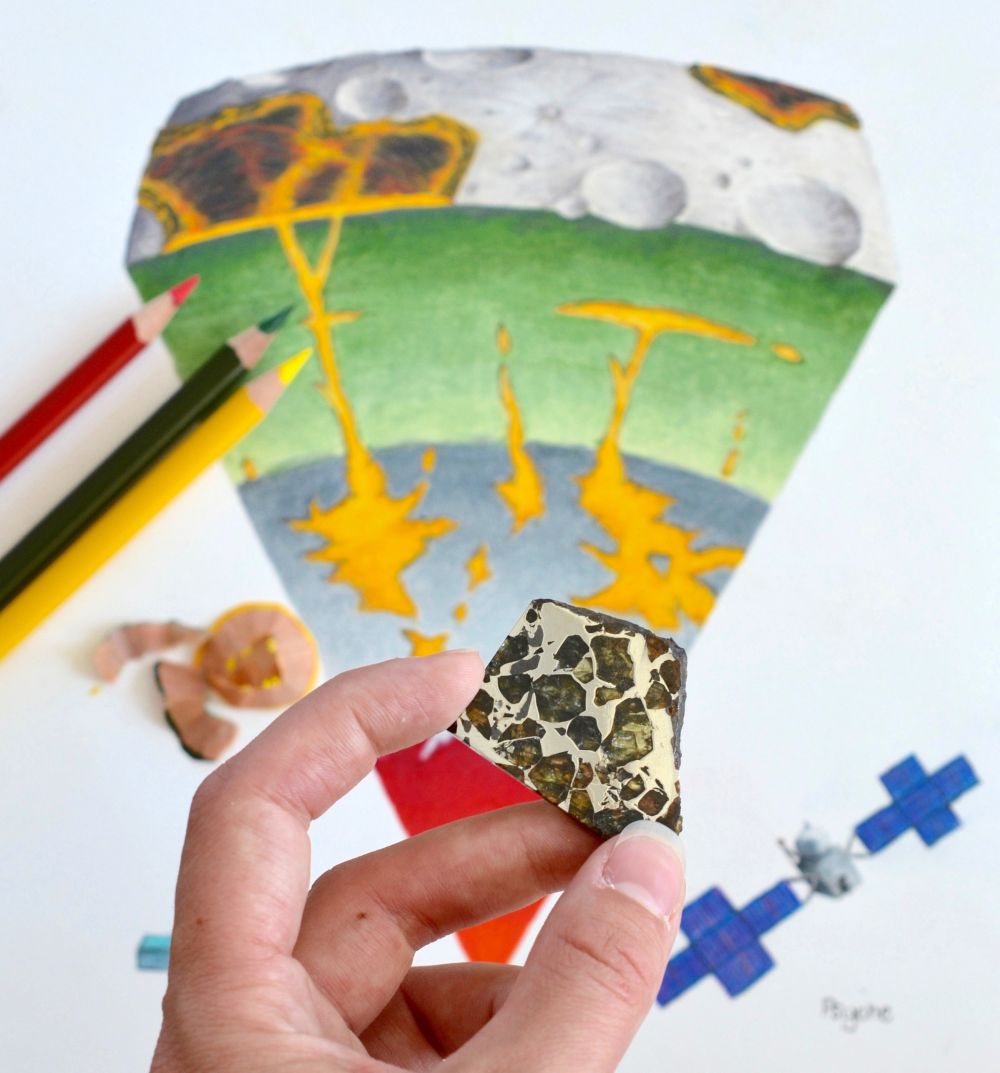
Remember the asteroid Psyche? It’s the largest known asteroid in the asteroid belt between Mars and Jupiter. It’s been in the news because of its unusual properties, and because NASA plans to launch a mission to Psyche in 2022.
Psyche, aka 16 Psyche, is unusual because it’s quite different from other asteroids. Psyche appears to be the remnant, exposed nickel-iron core of an early planet. Because of that, Psyche is a building block left over from the early Solar System, when planets were still forming. It’s like a planet without a crust.
Continue reading “Metallic Asteroids Might Have Had Volcanoes Erupting Molten Iron. That’s So Metal”Who Wants to be a Trillionaire? Mission to Psyche Could Uncover Tons of Precious Metals!
It has been said that within the next quarter century, the world’s first trillionaires will emerge. It is also predicted that much of their wealth will stem from asteroid mining, a burgeoning space industry where minerals and volatile compounds will be harvested from Near-Earth Asteroids. This industry promises to flood the market with ample supplies of precious metals like gold, silver
Beyond Earth, there’s the long-term prospect of the Main Asteroid Belt, which would provide even greater abundance. This is one of the reasons why NASA’s Psyche mission to explore the metal asteroid of the same name in the Main Belt has many people excited. While the exploration of this body
Mission to Metal World Takes a Big Step Forward with Thruster Test
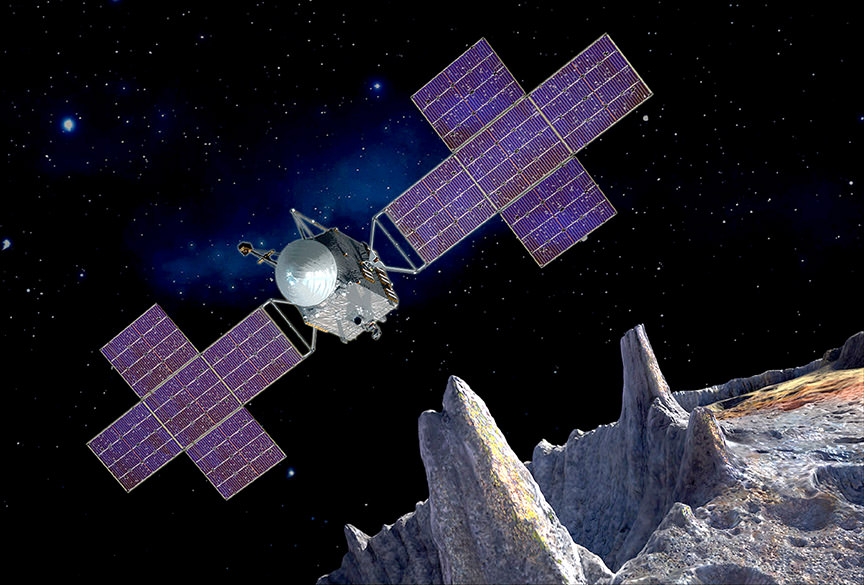
As NASA sets its sight on the next generation of space exploration, one area of focus is on missions that can teach us more about our Solar System. This was a major priority during the thirteenth round of NASA’s Discovery Program, which put out the call for proposals back in February of 2014. One of the proposals to make the cut was the Psyche mission, which will send an orbiter to the asteroid of the same name in 2o22.
This mission is unique in that it will entail visiting an asteroid that is entirely composed of metal, which scientists believe is the remnant core of an early planet. For the sake of the mission, NASA’s Glenn Research Center has been working hard to develop a cutting-edge, next-generation thruster that balances power with fuel efficiency. This thruster was recently subjected to tests designed to simulate its journey through space.
Originally discovered in 1852, the object known as 16 Psyche has been a source of fascination ever since astronomers were able to determine its composition. Unlike other asteroids that are largely carbonaceous (C-type), silicate (S-type), or composed of rock and metal (M-type), Psyche is the only asteroid to date that has been found to have an exposed nickel-iron surface.
Because of its unique nature, scientists have theorized that the metal asteroid is actually the core of a Mars-sized planet that formed during the early Solar System. This planet, they theorize, lost its outer layers after experiencing a massive collision, thus leaving an exposed core behind. The study of this asteroid is therefore expected to reveal a great deal about the interior of terrestrial planets and what powers their magnetic fields.
As David Oh, the mission’s lead project systems engineer, said in a recent NASA press release:
“Psyche is a unique body because it is, by far, the largest metal asteroid out there; it’s about the size of Massachusetts. By exploring Psyche, we’ll learn about the formation of the planets, how planetary cores are formed and, just as important, we’ll be exploring a new type of world. We’ve looked at worlds made of rock, ice and of gas, but we’ve never had an opportunity to look at a metal world, so this is brand new exploration in the classic style of NASA.”
The Psyche missions brings together researchers from Arizona State University and experts from NASA’s Jet Propulsion Laboratory. For the sake of designing the engine that would send their spacecraft to its destination, the joint Arizona-JPL team turned to NASA’s Glenn Research Center, which has been conducting research into Solar Electric Propulsion (SEP) for years.
SEP thrusters are essentially ion-engines that rely on electrically-charged inert gases (like xenon) to provide thrust. Like all Hall Effect ion-engines, this allows the thruster to provide a gentle, non-stop stream of thrust that gradually pushes a spacecraft up to greater and greater speeds. Such a system is ideal for deep-space missions where fuel-efficiency is a must.
As Carol Tolbert, the project manager for Psyche thruster testing at NASA Glenn, explained:
“For deep space missions, the type and amount of fuel required to propel a spacecraft is an important factor for mission planners. A SEP system, like the one used for this mission, operates more efficiently than a conventional chemical propulsion system, which would be impractical for this type of mission.”
The Psyche mission, which will be built jointly by JPL and Space Systems Loral (SSL), will use a SPT-140 Hall effect thruster that relies on solar power to provide electrical charges. The reduced fuel mass of this thruster will allow the mission to enter orbit around the metal asteroid while also providing additional space for the mission’s suite of scientific instruments.
These include a multispectral imager, a magnetometer, and a gamma-ray spectrometer, all of which will help the science team to obtain vital information on the asteroid’s origin, composition and history. The SEP also provides flexibility and robustness in the mission flight plan, since it will allow Psyche to get to its destination with greater speed and efficiency than conventional propulsion would allow for.
To test how the thruster performs during low-power operations, engineers at NASA Glenn placed the thruster into a space environment chamber designed to generate the low-pressures and temperatures it will encounter in space. As Carol explained:
“This mission will be the first to use a Hall effect thruster system beyond lunar orbit, so the tests here at Glenn, which had never been conducted before, were needed to ensure the thruster could perform and operate as expected in the deep space environment.”
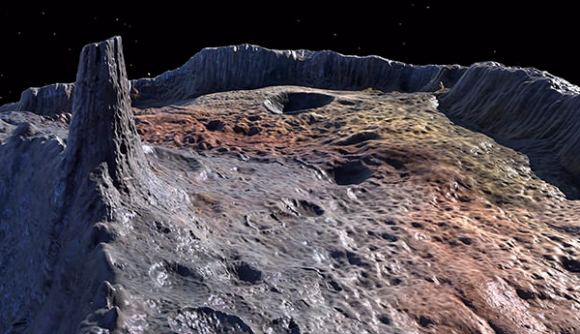
For decades, the Glenn center has used its compliment of chambers to simulate the conditions missions will encounter in space. However, this test is the first time that engineers have sought to determine how an SEP Hall-Effect thruster would fare. As Oh explained, this test is very important since it will simulate precisely how the spacecraft will fly, and the results have been encouraging so far:
“Glenn has a world-class facility that allowed us to go to very low pressures to simulate the environment the spacecraft will operate in and better understand how our thrusters will perform around Psyche. At first glance, the results confirm our predictions regarding how the thruster will perform, and it looks like everything is working as expected. But, we will continue to refine our models by doing more analysis.”
As the team works towards the mission’s proposed launch – which is scheduled for August 2022 – they will use the data collected at NASA Glenn to update their thruster modeling and incorporate it into mission trajectories. Once the spacecraft reaches its destination – the planned arrival will take place by 2026 – it is expected to reveal a great deal about this unique asteroid.
This data is also likely to teach us much about the history of the Asteroid Belt and the Solar System. If indeed 16 Psyche is the remnant of a Mars-sized planet that formed in the Main Belt, it could cause astronomers to rethink their notions of how the Solar System formed and evolved.
Further Reading: NASA
NASA Announces Missions to Explore Early Solar System
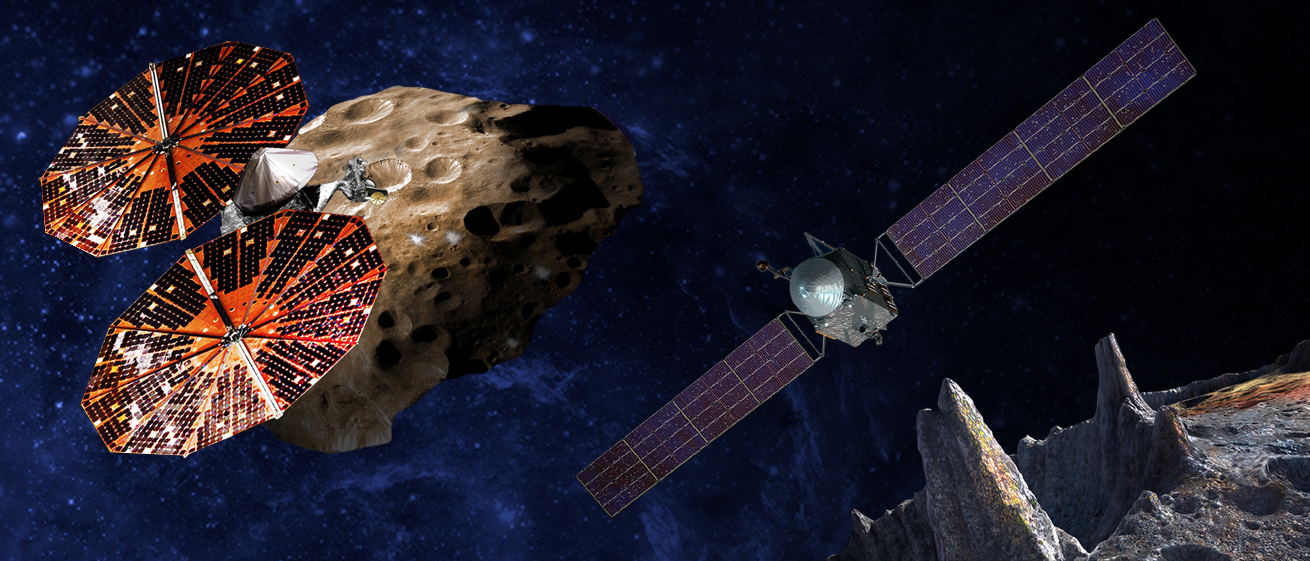
It’s a New Year, with new challenges and new opportunities! And NASA, looking to kick things off, has announced the two new missions that will be launching in the coming decade. These robotic missions, named Lucy and Psyche, are intended to help us understand the history of the early Solar System, and will deploy starting in 2021 and 2023, respectively.
While Lucy’s mission is to explore one of Jupiter’s Trojan asteroids, Psyche will explore a metal asteroid known as 16 Psyche. And between the two of them, it is hoped that they will answer some enduring questions about planetary formation and how the Solar System came to be. More than that, these mission represent historic firsts for NASA and human space exploration.
NASA’s Discovery Program, of which Lucy and Psyche are part, was created in 1992 to compliment their larger “flagship” programs. By bringing scientists and engineers together to design missions, the Discovery Program’s focus has been to maximize scientific research by creating many smaller missions that have shorter development periods and require less in the way of operational resources.
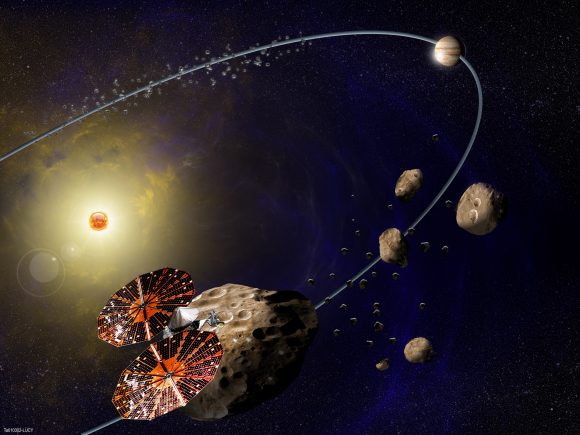
The Lucy mission is scheduled to launch in October of 2021, and is expected to arrive at its first destination (a Main Belt asteroid) in 2025. It will then set course for Jupiter’s Trojans, a group of asteroids that are trapped by Jupiter’s gravity and share its orbit. These asteroids are thought to be relics of the early Solar System; and between 2027 and 2033, Lucy will study six of them.
In addition to being the first mission to explore Jupiter’s Trojan population, Lucy is also of historic importance because of the number of asteroids it will visit. Throughout the course of its mission, it is will investigate six Trojans, which is the total number of Main Belt asteroids that have been studied to date. The nature of these six asteroids is also expected to tell us much about the early history of the Solar System.
As Harold F. Levison – the principal investigator of the Lucy mission from the Southwest Research Institute (SwRI) in Boulder, Colorado – explained during a NASA call-in briefing:
“One of the surprising aspects of this population is their diversity. If we look at them through telescopes on the Earth, we see that they are very different from one other in their color, in their spectra. And so, we believe that’s telling us something about how the Solar System formed and evolved… This diversity in these objects, we believe, are due to the fact that they actually formed in very different regions of the Solar System, with very different physical characteristics. And something occurred in the history of the Solar System where these objects started off at very different distances, but during the formation and evolution of the Solar System, they got moved around and placed in these stable reservoirs near Jupiter’s orbit.”
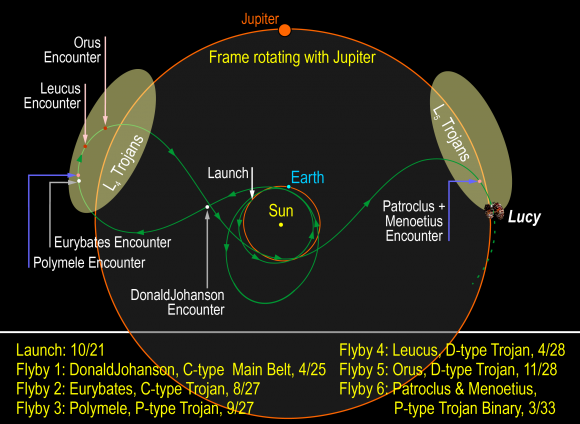
The six Trojans that Lucy is intended investigate were selected because the diversity of their physical characteristics show that they are from different locations throughout the Solar System. As Levison put it, “These small bodies really are the fossils of planet formation, and that’s why we named Lucy after the human ancestor known as Lucy.”
In addition, Lucy will build on the success of missions like New Horizons and OSIRIS-REx., which includes using updated versions of instruments they used to explore Pluto, the Kuiper Belt, and the asteroid Bennu -i.e. the RALPH and LORRI instruments and the OTES instrument. In addition, several members of the New Horizons and OSIRIS-REx science teams will be lending their expertise to the Lucy mission.
Similarly, the Psyche mission will of be immense scientific value since it will visit the only metal asteroid known to exist. This asteroid measures about 210 km (130 mi) in diameter and is believed to be composed entirely of iron and nickel. In this respect, it is similar to Earth’s metallic core, as well as the cores of every terrestrial planet in the Solar System.
It is for this reason why scientists believe it may be the exposed core of a Mars-sized planet. According to this theory, 16 Psyche experienced several major collisions during the early history of the Solar System, which caused it to shed its rocky mantle. The robotic probe will launch in 2023 and is expected to arrive by 2030 – after receiving an Earth gravity-assist maneuver in 2024 and a Mars flyby in 2025.
By measuring its composition, magnetic field, and mapping its surface features, Lucy’s science team hopes to learn more about the history of planetary formation. As Lindy Elkins-Tanton – the Principal Investigator of Psyche and the Director of the School of Earth and Space Exploration at Arizona State University – said during the NASA call-in briefing:
“Humankind has visited rocky worlds and icy worlds and worlds made of gas. But we have never seen a metal world. Psyche has never been visited or had a picture taken that was more than a point of light. And so, its appearance remains a mystery. This mission will be true exploration and discovery. We think that Psyche is the metal core of a small planet that was destroyed in the high-energy, high-speed, first one-one-hundredth of the age of our Solar System. By visiting Psyche we can literally visit a planetary core the only way humanity can… Psyche let’s us visit inner space by visiting outer space.”
Not only are planetary cores thought to be where magnetic fields originate (which are necessary for the emergence of life), but they are entirely inaccessible to us. The very edge of Earth’s outer core is roughly 2,890 km (1790 mi) from our planet’s surface. But the deepest humanity has ever dug has been to a depth of 12 km (7.5 mi), which took place at the Kola Superdeep Borehole, in Russia.
In addition, within the Earth’s core, temperature and pressure conditions are estimated to reach 5700 K (5400 °C; 9752 °F) and 330 to 360 gigapascals (over three million times normal air pressure). This makes exploring the core of our planet (or any other planet in the Solar System, for that matter) completely impractical. Hence why a robotic mission to a world like Pysche is such an opportunity.
And since Psyche is the only rounded body of metal that is known to exist in the Solar System, the asteroid is as improbably as it is unique. And since no missions have ever taken place to explore its surface, and no pictures exist that can tell us what its surface features would look like, the Psyche mission is sure to shed some serious light on what a metal world looks like.
“What do we think it might look like?” asked Tanton. “Does it have surface sulfur lava flows on its surface? Is it covered with towering cliffs created when solidifying metal shrank and the exterior of the body broke into fault? Is its surface a combination of iron metal and green mineral crystal as iron meteorites are? And what does an impact crater in metal look like? Could its edges or its metal flashes become frozen in the cold of space before they fell back on the surface. We don’t know.”
Jim Green, NASA’s Planetary Science Director, expressed enthusiasm for the Discovery 13 and 14 missions in a recent NASA press release:
“These are true missions of discovery that integrate into NASA’s larger strategy of investigating how the solar system formed and evolved. We’ve explored terrestrial planets, gas giants, and a range of other bodies orbiting the sun. Lucy will observe primitive remnants from farther out in the solar system, while Psyche will directly observe the interior of a planetary body. These additional pieces of the puzzle will help us understand how the sun and its family of planets formed, changed over time, and became places where life could develop and be sustained – and what the future may hold.”
Lucy and Psyche were chosen from five finalists that were selected for further development back in September 2015. These in turn were chosen from 27 mission concepts that were submitted back in November of 2014. Examples of past and present Discovery missions include the Kepler space probe, the Dawn spacecraft, the Mars Pathfinder, and the InSight lander (which is scheduled to launch in 2018).
Further Reading: NASA

